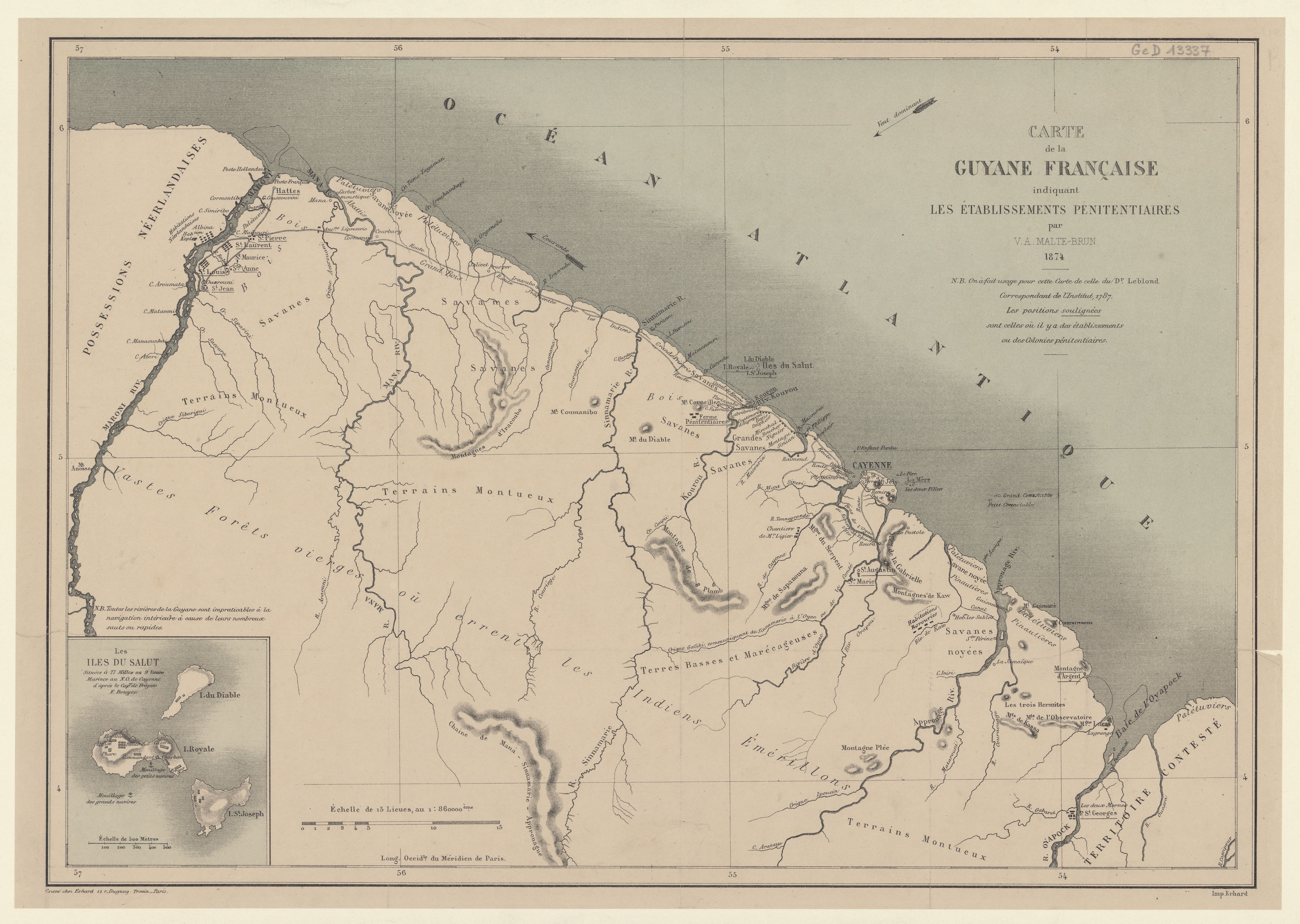Abstract
In 1874, the Department of Security commissioned the geographer and cartographer Victor Adolphe Malte-Brun (1816-1889) to depict the localization of penitentiaries in French Guiana. Besides the several localizations by the margins of the rivers, including the place of Kourou and the establishment in the islands, Malte Brun identifies any territory below the coast as the “[v]ast wild forests in which the Indigenous Émérillon wander.”
The deaths of more than 7 000 European migrants who looked to establish a new colony in Kourou between 1764 and 1765 not only censured any project for increasing French Guiana’s population via European migration but maintained the modest economic profits the colony offered to the French Empire. Still, after the strepitous failure of Kourou, the French Government gave a new propose to the land. In 1795, the French Directory began deporting political convicts to Guiana.1 Therefore, the previous land of El Dorado became l’infer vert (the green hell): the undesired destiny for prisoners and dissidents of the French political regime.2
Between 1852 and 1854, King Napoleon III sanctioned the legal normative to officially establish French Guiana as deportation point for prisoners and exiles from the whole Empire.3 Thereafter and until 1953, the colonial administration strengthened a network of bagnes (places of forced labor) across the country, with the refurbished purpose of using incarcerated people’ labor to exploit Guianese soil. Some of the penitentiaries became profitable coffee, tobacco, and sugar plantations.4 Another objective of the forced labor was to expand the colonial control in the region. The prisoners also built administrative venues and civil infrastructure, particularly a basic road network. However, the high levels of mortality due to the precarious sanitary conditions and harsh labor dynamics invite current scholars to affirm that the bagnes’ primary purpose was one of “social hygiene:” to remove undesirable people from the French Empire.5
The map shows a parallel narrative. The vagueness information about the dwellings of the Indigenous people forced the cartographer to reduce them all under the name Émérillon (today Teko) and place them over an unlimited area. In this case, the generalization could be attributed to the unawareness of the actual distribution and location of the Native population. Only the habitation of the Rorouies (Wayana) appears distinctly on the map. Despite its silence, the map also shows some practices of the Indigenous people. For example, it represents a path that joins Kourou with the villages on the Maroni River and says, “route frequently used by the Indians.” In this sense, despite the cartographer’s aim to show French Guiana as a domain of the French, its attentiveness to the coastal region and the bare representation of the inland as an almost uninhabited space confirms that the land and the people remained alien from complete colonial control.
Map citation:
Victor-Adolphe Malte-Brun. Carte de la Guyane française indiquant les établissements pénitentiaires. Map, 48 x 34 cm. Paris, 1874. Bibliothèque National de France – Gallica. Accessed August 12, 2023. https://gallica.bnf.fr/ark:/12148/btv1b8490883k
Serge Mam-Lam-Fouck and Apollinaire Anakesa-Kululuka, Nouvelle histoire de la Guyane Française: des souverainetés amérindiennes aux mutations de la société (Matoury, Guyane: Ibis rouge, 2013), 41. ↩︎
Pluchon and Abénon, Histoire des antilles et de la Guyane (Toulouse: Privat, 1982), 324. ↩︎
Olivier Puaux, Michel Philippe, and Régis Picavet, “Introdution,” Archéologie et histoire du Sinnamary du xviie au xxe s. (Guyane), (Paris: Éditions de la Maison des sciences de l’homme, 1997). ↩︎
Denis Lamaison, “« Le bagne de la mort ». Culture du café et situation sanitaire au pénitencier agricole de la Montagne d’Argent (Guyane française) de 1852 à 1910,” Outre-Mers, vol. 390-391, 1 (2016): pp. 291-320. ↩︎
Pierre Morlanne-Fendan, Margot Battesti, Xavier Deparis, & Marc Tanti, “État sanitaire des condamnés à l’époque du bagne de Guyane,” Histoire de Sciences Medicales, tome XLVII, n° 2 (2013): 186. ↩︎
